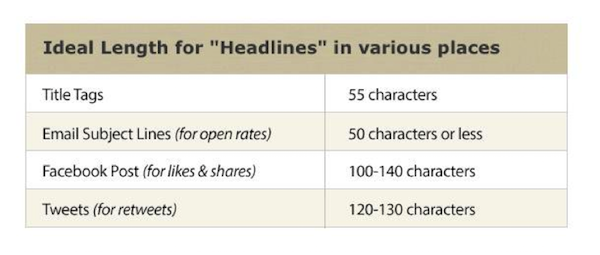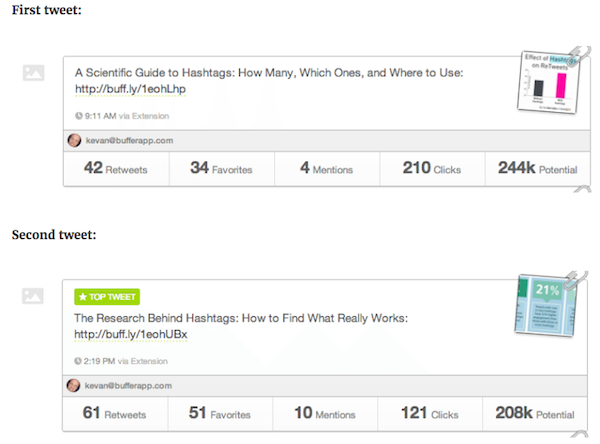It’s scary, isn’t it?
Only 20% of people who scan your headline will continue reading your content.
In fact, this number is likely to decline as the online world continues to become even more saturated and fast-paced. If you want your content marketing campaigns to be successful, then it’s time to start creating headlines that your readers just can’t ignore.
Ready to learn how to write compelling, attention-grabbing headlines that convert casual browsers into readers? Let’s dive in to the steps…
Step 1. Write a Draft Headline
When it comes to content marketing, people often ask me,
“Which comes first, the headline or the content?”
It’s the famous riddle of the chicken or the egg. The answer is, there’s no hard and fast rule. But what I’ve personally found to work best is to start off with a draft headline.
A draft headline is simply a rough version of your headline that you are going to tweak and perfect later.
Before you write your draft headline, you should have already chosen a topic for your post that addresses a problem that your buyer persona faces. From there, you can create a basic headline, such as a simple “how-to” headline. For example the headline I started with for this particular post was, How To Write Powerful Headlines.
It’s quite dull and boring, but it doesn’t matter because you’re going to work your magic on it later. This just gives you a starting point for writing your post.
Now that you’ve written your draft headline, you can move on to Step 2…
Step 2. Write 25-30 Headline Variations
With your draft headline written, start writing your content. When you’ve finished writing your content, you can start tweaking and improving your draft headline by writing 25-30 different variations.
That’s right– you’re going to write at least 25 headlines.
Why 25? Here are three compelling reasons why you shouldn’t skip this step…
First, you get better when you practice.
There’s scientific evidence that proves we get more creative the more we write. It’s true: your brain is wired to continue creating when you stimulate it.
So by forcing yourself to write ten headlines, you’ll soon have another five without even thinking about it. But don’t take my word for it…
- Upworthy writes 25 headline variations
- CoSchedule writes 25-30 headline variations
- Buffer writes 25-30 headline variations
Second, you can use these variant headlines elsewhere.
When you publish and promote your content, your headline will likely appear in a number of different places and platforms. For instance, a blog post, email, social media, and search engines at the least. And guess what? You don’t have to use the same headline every time.
In fact, I recommend that you use different headlines in different places. For example, you could use a different headline for every tweet about your blog post.
Third, you don’t know which headline will perform the best until you test it.
Right now, you have no idea which of your 25 headlines is going to prove the most click-worthy. You might have your own favorite, or a sneaky suspicion. But the truth is, it’s an unknown until you actually test it. (We’ll talk more about testing in Step 5.)
Still feeling overwhelmed with the thought of writing 25-30 headlines? Don’t fret. A simple way to come up with many different headline variations is to use a popular headline formula.
Here are three popular types of headlines for you to try, with fill-in-the-blank formulas…
The How-To Formula: How to [Achieve Something Specific]
We’re naturally drawn to articles that tell us how to do something in a practical way. When you want a quick answer to a problem, what do you do? Head over to Google and type your question in a how-to format (e.g. “how to lose weight).
Examples of how-to headlines:
- How to Hide Pop-Ups from Your Existing Subscribers (4 Methods)
- How to Create an Optin Feature Box Step-by-Step (with Examples)
- How to Use Google Analytics to Discover Ideas for Lead Magnets
The List Post Formula: [Number] [Adjective] Ways to [Achieve Something Specific]
We are fascinated with numbers. We’re just wired that way. You can either use a classic list post, or include a number (in actual digits) in the headline.
Examples of list post headlines:
- 30 Content Upgrade Ideas to Grow Your Email List
- 7 Proven Steps to Grow Your Email List on Pinterest
- 22 Traffic Hacks to Drive Email List Signups
The Question Formula: Ask a question that incites curiosity.
Questions tend to arouse curiosity. Close-ended questions convert really well. A close-ended question prompts you to say either “yes” or “no” in your head.
Examples of question headlines:
- Are you using hashtags like you should be?
- What is the best placement for successful social media buttons?
- Want to be a marketing pro?
Try writing 10 headlines for each of the three types above, and then you’ll have 30 headlines right there!
Step 3. Boost Your Headlines with Sensory Power Words
Power words are persuasive words that people simply can’t resist. Add power words to your list of headlines, and you’ll take them to a whole new level.
For a comprehensive list, check out our enormous list of 700+ power words that will boost your conversions.
Sensory words are power words that evoke the senses and bring your headlines to life by activating the imagination of your readers.
As Henneke says:
“[Sensory words] help readers see, feel, hear, taste, or even smell your words; and that’s why they engage more brain power and attract more attention.”
For example, 28 Ways to Dazzle Your Followers with Colorful Tweets.
Pro tip: Use a thesaurus to search for synonyms. It will help you transform your headlines from dull to delightful, just by tweaking a few words!
Step 4. Analyze Your Headlines
Now you’ve created 25-30 headlines, and you’ve boosted them with power words. What’s next?
Time for some analysis.
I like to pop my headlines into the CoSchedule Headline Analyzer. This is a free tool that rates your headline’s ability to result in social shares, increased traffic, and SEO value.
It grades your headline based on a few factors:
- Word Balance
- Headline Type
- Headline Length
- Headline Sentiment
If your headline meets all the criteria, then you’ll score a reassuring 70+.
That being said, this is just a tool. There’s no harm in analyzing your headline, but don’t sweat on the score. I’ve known headlines to get a low score but then spread like wildfire.
Whether you use the tool or not, you should now pick a few headlines to use for your post before you move on to Step 5…
Step 5. Optimize Your Headlines
Now that you have chosen a few headlines that you actually want to use, you’ll need to optimize them for the various places where they will appear.
The most important thing to take into consideration at this point is your headline size.
Your headline will likely appear in each of these places:
- Blog post title (<H1>)
- Search engine results (<META TITLE>)
- Email subject line
- Social media posts
Unfortunately, one size does not fit all. For example, if your headline is too long for the search results, then this is what your potential visitors will see:
Not too enticing, is it?
However, your blog post H1 Title can be longer than your search engine Meta Title. As I mentioned earlier, this is one of the reasons you should have 25-30 variations of your headline.
To help you keep track of the different optimal headline sizes, here’s a handy reminder from Andy Crestodina:
If you’re using the All in One SEO tool, then you can easily place different headlines in your Meta, Facebook, and Twitter titles. Here’s an example of the Twitter headline:
Step 6. Test and Evaluate
Now we come to the 6th and final step! You’ve come a long way…
- You started with a draft headline.
- You crafted 25-30 variations.
- You boosted your headlines with power words.
- You analyzed them and picked a few potential winners.
- You even optimized them to make sure that they’d fit in all the right places.
So now it’s time to publish your content and enjoy the fruits of your labor, right?
Not so quick.
Before you hit “publish”, you might want to think about setting up some split tests to evaluate just how good your headlines really are.
Since you’re going to use you headlines in different places, you’ll have to create separate tests for each one. Fortunately, there are some tools that can make this process simple and easy for you.
WordPress
There are a few plugins, both free and premium, for WordPress that allow you to test headlines. Here’s a quick roundup of four of them. Optimizely also has a WordPress plugin to use with their A/B testing software.
Also, check out these useful tutorials from WPBeginner on how to run A/B tests in WordPress and how to use Google Analytics Content Experiments.
Most email marketing software will have A/B testing features built in. Here, you can enter at least two headlines and then see which one gets the best open rate and the best click-thru rate.
Social Media
If you use a social media scheduling tool like Buffer, then you can check their built-in analytics to see how various tweets performed.
In this article, Kevan explains how Buffer changed their tweet headline from “A Scientific Guide to Hashtags” to “The Research Behind Hashtags.” Note the big difference in retweets, favorites, mentions, and reach in the comparison below.
Look to see how many clicks you get: this is the measure of how many people were intrigued by the headline enough to click and read more on your blog. Shares and retweets are good, but a click is a better indicator of headline effectiveness.
If you don’t use Buffer, then check directly in Twitter and Facebook Analytics. Both platforms provide many useful performance insights.
(Note: the downside with social media testing is that different people see different tweets at various times of the day. So it’s not a 100% accurate test, but it still provides a useful indication.)
Bonus Step 7. Don’t Forget Your Sub-headings
You did a great job! You created a headline that attracted your readers’ attention– now you have to keep their attention.
Once a user has clicked through to your web page, you need to make their visit as “sticky” as possible.
The average attention span is 8.25 seconds. (Yes, that’s less than a goldfish!) So the body of your content needs to be clearly sign-posted as the average reader will whizz past.
Give them a clear outline with sub-headings that are action-based, and keep arousing curiosity so visitors are compelled to read on.
Conclusion
You’ve reached the end! (I must have done a good job with my headline and sub-headings.)
Now you’re armed with 6 simple steps to write attention-grabbing headlines that convert and drive traffic to your web content.
Did you enjoy this article? Well then we have something you’ll really love. OptinMonster now has a headline analyzer to help you write better headlines! Check out OptinMonster’s headline analyzer now.
How much time do you invest in writing headlines compared to your content? How many headlines do you write for each post? Let me know in the comments.















Add a Comment